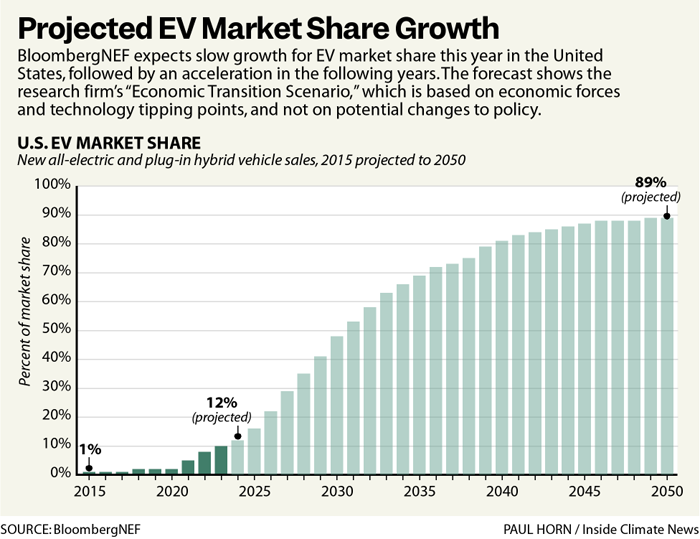When Will the EV Sales Slump End? Here’s What the Experts Say
U.S. electric vehicle sales have slowed in 2024. So how long will this period last?
I spoke with auto analysts this week to try to get answers to this and other questions. The conversations covered the market as a whole and models whose sales have been surprisingly strong.
1. When will the U.S. market shift back to rapid growth?
First, let’s define the current moment: Sales of new EVs are growing but at a slower pace than they did last year.
Sales in the U.S. rose 7.3 percent in the first half of 2024 compared to the same period in 2023, according to Cox Automotive. That’s much less than the 47 percent growth in the first half of 2023 compared to the same period in 2022.
Explore the latest news about what’s at stake for the climate during this election season.
The reduction in the growth rate is happening at the same time that automakers have made announcements pushing back timetables for a shift to EVs. For example, Ford said in August it is canceling plans for a three-row electric SUV and delaying the introduction of a next-generation electric pickup from 2026 to 2027. Volvo said this month that it has decided to “adjust its electrification ambitions” by abandoning a previous pledge to stop global sales of gasoline vehicles by 2030.
“It’s clear that in the near term, automakers are taking a bit of a step back from their EV goals, whether it’s that the targets were set too ambitiously, or they have struggled to build a platform over time,” said Corey Cantor, an analyst for the research firm BloombergNEF.
This moment is also an opportunity.
“The stepping back of certain automakers means that there is room for others to step into to capture more market share,” he said. Hyundai and Kia are examples of brands that are increasing their market share, while the sales leader, Tesla, has been losing some of its portion.
Cantor expects that the U.S. market will accelerate its growth a bit in 2025 and then enter a period of rapid growth in 2026 and 2027.

This is reflected in BloombergNEF’s most recent EV forecast, issued in June, which projects that all-electric vehicles and plug-in hybrids will be 12 percent of new sales in the U.S. market this year, followed by 16 percent in 2025, 22 percent in 2026 and 29 percent in 2027.
Growth would accelerate around 2026 for many reasons, including an increase in EVs priced to appeal to the middle of the market and because of the continuing buildout of charging infrastructure.
Others have similar outlooks. Morgan Stanley, the financial services company, said this month that it expects the global EV slowdown to continue for another 12 to 18 months.
2. Is the EV slowdown also happening outside of the United States?
While the United States and the European Union are struggling to gain momentum on EVs, China is doing better and is further along in its shift to electric transportation.
Analysts for Raymond James, the financial services company, showed the scale of China’s dominance in an August report for its clients. EVs are approaching half of new cars and light trucks sold in China, and eight of the top 10 best-selling EVs in the world are made by Chinese companies. The exceptions are Tesla’s Model Y and Model 3, which rank first and third in global sales.
“It is emphatically not the U.S. market where EV adoption is progressing the fastest,” said the report, co-written by analyst Pavel Molchanov.
China has been successful at developing its EV economy to the point that prices of new vehicles are now low enough for that nation’s typical driver to afford. The BYD Seagull, which ranks fifth on the list of global bestsellers, has a sticker price of about $10,000.
There is a danger for U.S. and European automakers that China will get so far ahead in building its EV industry that others won’t be able to compete. Countries could put up trade barriers, such as the United States’ 100 percent tariff on imported Chinese cars, but that doesn’t stop China from making inroads almost everywhere else in the world.
Competition from China is one reason that U.S. automakers, who want to compete globally, need to be careful about delaying their plans.
3. What EV models have had the strongest debuts?
At the top of this list is the Honda Prologue, an SUV assembled in Mexico using a version of the Ultium battery platform developed in partnership with General Motors. Its base price is $48,795 before a $7,500 federal tax credit.
The Prologue sold 5,401 units in August after making its debut in April and slowly ramping up sales.
That’s more than the Ford Mustang Mach-E, which sold 5,341 units in August. The Mach-E is one of the top-selling EVs in the country, but we don’t know how it or the Prologue ranked in August compared to all EVs because several companies don’t do monthly sales reports.
“This is a competent product,” said Ivan Drury, director of insights for Edmunds, the vehicle information website.
That may sound like faint praise, but he doesn’t mean it that way. He explained that Honda’s customer base has been waiting for years for an electric SUV, so there was an audience eager to buy the Prologue, so long as it felt like a Honda—and it does. (Edmunds gave the Prologue a mixed review, but others, including Motor Trend, have been more enthusiastic.)
It’s too soon to declare the Prologue a hit, since we’re talking about just one month of strong sales. But if the model can maintain or increase those numbers, people will be high-fiving in Honda’s sales department.
Drury singled out the Cadillac Lyriq as an EV that feels like a new model in 2024, even though it’s been available since late in 2022, and has been a strong seller. Its introduction was hindered by delays, so it feels newer than it is. The ramp-up of production was so slow that customers who had pre-ordered the model had to endure long waits.
But production has now grown to meet demand. Cadillac dealers sold 13,094 of the Lyriq in the first half of this year, an increase of more than 400 percent from the first half of last year, and more than European luxury rivals such as the Mercedes EQB. The base price is $57,195 before a $7,500 tax credit.
Other notable models this year include the Chevrolet Equinox EV, which began to arrive in May. We don’t have enough data to know how well it’s selling.
The Equinox EV is aiming for a sweet spot of affordability, with a base price of $34,995 before a $7,500 tax credit, and lease offers as low as $299 per month.
One model that’s notably absent is the Volvo EX30, a highly anticipated compact SUV that was supposed to go on sale this year but has been pushed back to 2025, partly as a result of U.S. tariffs. Volvo, which is controlled by China-based Geely, has said it will shift production of the EX30 to Belgium.
The EX30 is not the only model to be delayed. The Equinox EV, for example, was supposed to be a 2023 debut before GM decided to wait and launch it this spring.
The delays can contribute to sluggish sales as consumers wait for certain models. Then automakers cite sluggish sales as a reason for additional delays. It can feel like a vicious cycle.
But this period of slow growth is going to end, analysts said. It’s just a question of when.
Other stories about the energy transition to take note of this week:
U.S. Solar Manufacturing Capacity Has Quadrupled Thanks to Climate Law: In the two years since the Inflation Reduction Act became law, domestic capacity for manufacturing solar panels has nearly quadrupled, according to the Solar Energy Industries Association and Wood Mackenzie. This expansion helps to reduce the country’s dependence on China as a supplier of solar components, as Eric Wesoff reports for Canary Media.
Biden’s Race to Spend Billions of Climate Bucks: The Biden administration has been busy allocating money from the Inflation Reduction Act, including the recent announcement of $7.3 billion in spending to help rural electric cooperatives boost renewable power. The administration aims to spend as much of the available funding as it can to reduce the ability of a potential Trump administration to cancel the funding, as Andrew Freedman reports for Axios.
Lithium Producers Buckle Up for Wild Swings in Prices: Companies that dig up and process lithium are dealing with a drop in prices for their product and uncertainty about how the presidential election may affect demand. As a result, the companies are laying off workers and scaling back projects, as Hannah Northey reports for E&E News. Low lithium prices are good for the consumers buying EVs and battery storage systems, but bad for the companies that sell lithium.
Toyota Gives Details on Solid-State Battery Production Plans: Toyota has been talking for years about developing solid-state batteries, designed to allow for longer ranges and shorter charging times. The automaker has filed a document with the Japanese government that provides an update on those plans, including that Toyota would begin production of the batteries in small quantities in 2026, as Andrei Nedelea reports for InsideEVs. This timetable would put Toyota among the leaders in getting solid-state batteries to market, but as I reported last month, plenty of observers remain skeptical about whether the company can achieve such an ambitious timetable.
Unionized Workers Making EV Batteries Downplay Politics of the Product: The United Auto Workers have been a visible part of the presidential campaign, with their leader, Shawn Fain, speaking in primetime at last month’s Democratic National Convention. I spent some time in Lordstown, Ohio, to meet with recently unionized workers at the Ultium Cells battery plant. The plant might not exist without Biden administration policies, but workers there are wary of the idea that EVs can be viewed as partisan.
Inside Clean Energy is ICN’s weekly bulletin of news and analysis about the energy transition. Send news tips and questions to [email protected].
About This Story
Perhaps you noticed: This story, like all the news we publish, is free to read. That’s because Inside Climate News is a 501c3 nonprofit organization. We do not charge a subscription fee, lock our news behind a paywall, or clutter our website with ads. We make our news on climate and the environment freely available to you and anyone who wants it.
That’s not all. We also share our news for free with scores of other media organizations around the country. Many of them can’t afford to do environmental journalism of their own. We’ve built bureaus from coast to coast to report local stories, collaborate with local newsrooms and co-publish articles so that this vital work is shared as widely as possible.
Two of us launched ICN in 2007. Six years later we earned a Pulitzer Prize for National Reporting, and now we run the oldest and largest dedicated climate newsroom in the nation. We tell the story in all its complexity. We hold polluters accountable. We expose environmental injustice. We debunk misinformation. We scrutinize solutions and inspire action.
Donations from readers like you fund every aspect of what we do. If you don’t already, will you support our ongoing work, our reporting on the biggest crisis facing our planet, and help us reach even more readers in more places?
Please take a moment to make a tax-deductible donation. Every one of them makes a difference.
Thank you,
David Sassoon
Founder and Publisher
Vernon Loeb
Executive Editor
Share this article
Disclaimer: The copyright of this article belongs to the original author. Reposting this article is solely for the purpose of information dissemination and does not constitute any investment advice. If there is any infringement, please contact us immediately. We will make corrections or deletions as necessary. Thank you.








